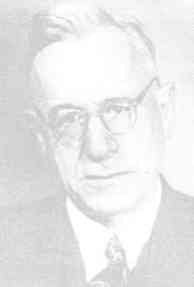
Hermann
Hussong was born in 1881 in Blieskastel. In 1900, after passing the Abitur in Zweibrücken, he started to study
Architecture at the Technische Hochschule
München, where he graduated
in 1905 as master builder and qualified engineer. During the following
years, he was employed alternately in Rhineland and Bavaria in the civil
service.
In 1909, he was selected
from a considerable number of applicants and appointed Stadtbauamtmann of Kaiserslautern for town
planning and structural engineering.. Hussong managed to integrate a multitude of competences into his office and
personality. His first task was to revise the plans for the extension
of the city of Kaiserslautern in order to comply with contemporary views
and conceptions. Considering generally bad social conditions and the serious
housing shortage, he was ahead of the stage of development of housing
policy of most other German cities when he planned an extensive housing
programme for Kaiserslautern during World War I. It was an advantage for
the city that his plans to build small housing units, which were to set
a new house-building standard, could be carried out right after the end
of the war, encouraging the foundation of the Bau-AG as a non-profit-making co-operative
in 1919 with Hermann Hussong as chairman.
After the city had
become an administrative district in its own right in 1920 and the Bezirksamt had ceased to function as a
supervisory body, a period of entirely independent work started for Hussong.
Elaborating the Staffelbauplan,
which served as a long-term basis for the development of the city, in
1919, he cleared the way for house building to be put on an orderly basis
in Kaiserslautern. In April 1920 he was promoted to Stadtbaurat and head of the
building control office and, half a year after that, Oberbaurat. In the following year, he was elected professional city
councillor. In 1931 Hussong was appointed Oberbaudirektor.
With his schemes
for the development of house building and his traffic engineering, his
housing units and further buildings, Hussong has had a formative influence
on Kaiserslautern up to our present day. While, on the one hand, he took
up traditional concepts like the idea of the garden city, on the other
hand, some of his constructions which were built at almost the same time
are impressive through their modern, clear, rationally and sober shapes
– very often with expressionistically influenced ornaments and intensive
colouring.
For many of his works
Hussong co-operated with regional artists and sculptors with whom he was
on friendly terms. This interest in art and culture is also reflected
in his numerous watercolour and charcoal drawings.
In 1933, the takeover
by the Nazis, who produced dubious accusations against Hussong, resulted
in a compulsory retirement for him, which meant that the family had to
move to Heidelberg. He was appointed Oberbaudirektor
there in 1945 and remained in office until he retired in 1952. Shortly
before the end of the war Hussong returned to Kaiserslautern for several
minor projects. However, several parties prevented him from conducting
the post-war reconstruction of the city. In 1960, Hermann Hussong died
in Heidelberg, aged almost 79.